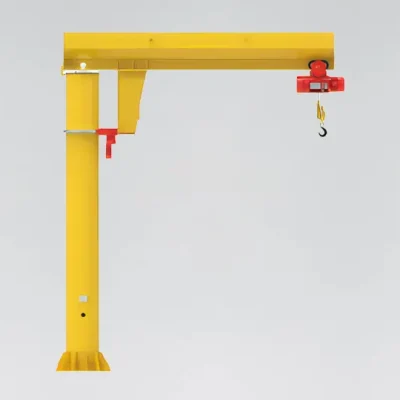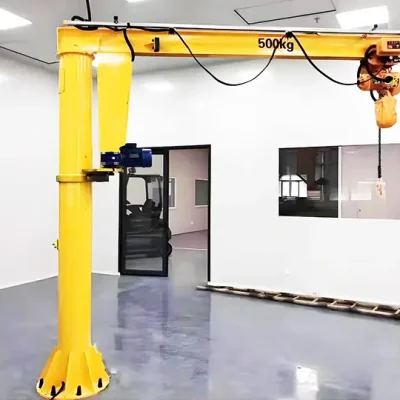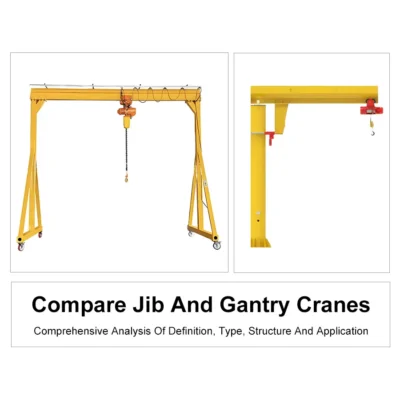

Nachrichten
A jib crane is a versatile lifting device consisting of a horizontal boom (jib) mounted on a vertical mast or wall bracket, used for precise material handling in workshops, warehouses, and production lines. Jib cranes typically have a maximum capacity ranging from 0.25 to 20 tons, depending on design (wall-mounted jib crane, freestanding jib crane, or articulating jib crane). Regular maintenance prevents breakdowns, ensures safety, and extends service life. Neglecting inspections can lead to mechanical failures, accidents, or costly downtime. This article will introduce daily jib crane maintenance points and troubleshooting tips for common failures to help users extend equipment life and ensure safe production.

Regularly inspect the welded parts of the column, swivel arm, and support arm, and find cracks, deformation, or corrosion that should be repaired in time. Check the tightness of connecting bolts to prevent loosening, leading to structural instability.
Regularly lubricate the moving parts, such as rotating bearings, rollers, and chains, and use lubricants that meet the requirements of the equipment to reduce friction and wear and prolong service life.
Check the motor, control cabinet, and electrical wiring to ensure firm wiring and good insulation. Prevent the equipment from losing control or shutting down due to electrical faults.
Regularly test limit switches, overload protection devices, and emergency stop buttons to ensure that they are sensitive and effective to prevent accidents in time.
Keep the equipment clean, remove dust, oil, and debris to prevent affecting mechanical movement and electrical safety.
| Failure phenomena | Possible causes | Troubleshooting methods | Maintenance Recommendations |
|---|---|---|---|
| Inflexible or jammed rotation | 1. Poor lubrication | 1. Check the lubrication system | 3. Check the roller area |
| 2. Bearing damage | 2. Manual rotation test | 1. Check the power supply system | |
| 3. Blocked rollers | 2. Replace the bearing assembly | 3. Clean track of foreign matter | |
| Slow or weak lifting | 1. Insufficient motor power | 1. Measure voltage and current | 2. Test the contactor relay |
| 2. Electrical failure | 1. Turn the test circuit on and off | 2. Replace electrical components | |
| 3. Chain wear/slackness | 3. Check chain condition | 3. Adjust or replace the chain | |
| Failure of electrical control | 1. Broken wiring | 2. Simulate an overload test | 1. Repair wiring |
| 2. Poor contact | 2. Check connectors | 2. Clean contacts | |
| 3. Controller failure | 3. Diagnostic control signals | 3. Replace the controller | |
| Failure of safety device | 1. Limit switch failure | 1. Manual trigger test | 1. Replace limit switches |
| 2. Overload protection failure | 3. Replace the bearing | 2. Calibrate sensors | |
| 3. short circuit | 3. Check safety circuits | 3. Repair wiring | |
| Abnormal noise/vibration | 1. Mechanical wear | 1. Auscultate the source of the noise | 1. Replace worn parts |
| 2. Loose fasteners | 2. Check bolt torque | 2. Retighten | |
| 3. Bearing failure | 3. Check bearing clearance | 3. Replace bearing |
1. Formulate a detailed maintenance plan with clear inspection cycles and responsible persons.
2. Record the maintenance and troubleshooting process for easy analysis and improvement.
3. Use original or reliable quality spare parts to ensure the quality of maintenance.
4. train the operators and maintenance personnel to improve the equipment management level.
The daily maintenance and troubleshooting of the jib crane are the basis for ensuring the stable operation of the equipment and operational safety. Through scientific maintenance management and timely troubleshooting, not only can the service life of the equipment be extended, but also effectively prevent accidents and improve production efficiency. We hope that the maintenance points and troubleshooting techniques in this article can provide you with practical help.
For more information about maintenance technology or customized services, please contact the Weihua team.



Datum:
Antrag einreichen